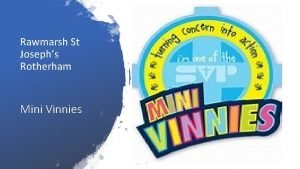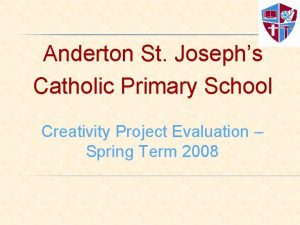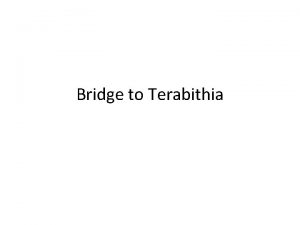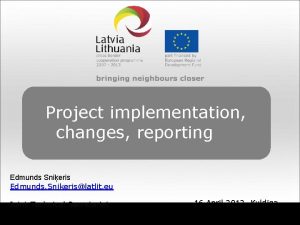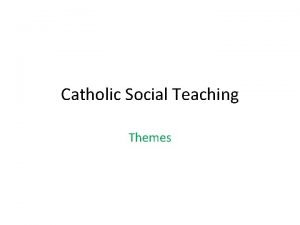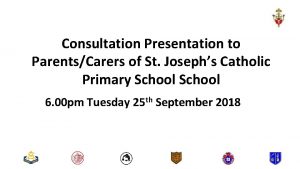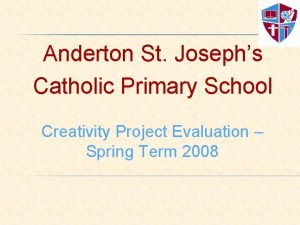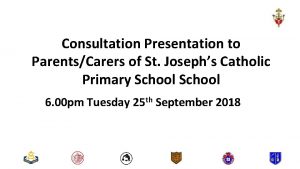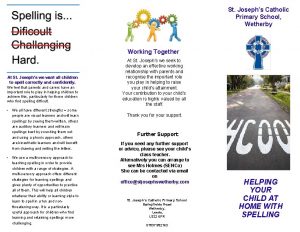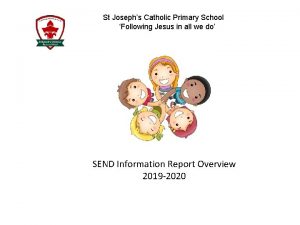The Federation of St Edmunds St Josephs Catholic
























- Slides: 24

The Federation of St Edmund's & St Joseph's Catholic Primary Schools

WHAT IS THE THRIVE APPROACH? Thrive helps adults prepare children and young people for life’s emotional ups and downs Thrive is rigorous, targeted and measured. Thrive tells you how to be and what to do with children’s differing and sometimes challenging behaviours to help them engage with life and learning.

WHY USE THRIVE? • Thrive helps address the problems caused by interrupted emotional development in children and young people. • What is ‘Interrupted emotional It underpins many troubling behaviours and leads development’ : to under-achievement It lies at the heart of many health and mental health problems and gives rise to adverse social issues and can be costly both monetary and socially to communities It isolates children from life and their learning

WHAT ARE THE BENEFITS? Thrive will helps you develop targeted interventions for groups and individual children Thrive tells you what to do and how to do it Thrive is easy to implement the non-therapeutic interventions Thrive allows you to measure and monitor progress

WHERE DOES THE APPROACH COME FROM? The Approach was devised in 1996 by four founder directors to front the challenge for children with unmet social and emotional needs.

WHAT IS THRIVE BASED ON? Establishe d research in neuroscien ce Child developm ent theory Attachm ent researc h Research into role of creativity and play

NEUROSCIENCE THE TRIUNE BRAIN Three interlocking systems Cortex The cognitive - thinking brain Limbic system The emotional. Brain stem mammalian The brain instinctualreptilian

THE INSTINCTUAL BRAIN Also known as the survival or reptilian brain. It is made up of the brain stem and cerebellum. Which are located at the base of the brain and connect directly to the spinal cord. The instinctual brain is responsible for coordinating and regulating the essential bodily functions needed for basic survival and maintain consciousness, including the regulation of breathing, temperature, movement and balance, hunger, digestions, circulation, heart rate and sleep cycles. Importantly the structures in this part of the brain are responsible for coordinating the fight/ flight or freeze response. Pre-birth to 6 months this part of the brain develops rapidly. A baby can only communicate and show distress through crying, smiling and eye contact. So holding and soothing, having eye contact, the world of the face, smiling, reassuring and repetition [singing, rhymes, talking] are critical for

THE MAMMALIAN BRAIN Also known as the emotional brain, refers to the limbic system. This comprises a complex set of structures, which cluster around the top of the brain stem. The limbic system is common to all mammals. Often described as the seat of emotions, the limbic system is largely responsible for monitoring our external environment for threats and opportunities, it is essential for alerting us to danger and enables us to recognise and experience pleasure and reward. Exploration and play are important to develop this part of the brain.

THE COGNITIVE BRAIN The cognitive brain, also known as the rational brain, refers to the cortex or neo cortex. The cortex comprises of two halves, the right and the left hemispheres. Each of the two hemispheres is divided into four lobes. The frontal lobes are largely responsible for our cognitive capabilities, the ability to think, predict, plan, reason and control our impulses; understanding cause and effect, language , creativity and imagination, reflection and self awareness. When operating effectively. The cognitive brain enables us to inhibit the responses of our emotions and instinctual brain in order to give us choice in how we respond to our environment.

DEVELOPMENTAL STAGES AS STRANDS Each comes online sequentially and remains in play throughout life.

EARLY DEVELOPMENT OF NEURAL PATHWAYS Neurons are the core component of the brain and nervous system. A neurons function is a bit like electrical wires carrying information along their length, via electrical impulses. Synapses are minute gap between a neuron and another cell across which information is transmitted using chemical signals. Myelination- Over time neural networks that are used particular frequently become myelinated and a pathway is formed. Pruning- Synaptic processes that are underused fall away. • Pruning and Myelination give the brain its neuroplacity. • Birth- neurons unconnected, like the dangling wires of a Computer. • By 18 months some neuron formed • 18 m-3 years - A child connections have become more complex and the pruning has begun. • Adulthood- Overall number of neuron and connections are reduced and pathways have become myelinated. • Repetitions – It takes about 500 or more repetitions to learn something new and form habits. In the context of thrive the children we work with will need repeated relational experiences. To develop positive neural

WHAT THE STAGES OF DEVELOPMENT LOOK LIKE Stages Normal development Interrupted development Being 0 -6 months Instinctual brain Confident, trusting, receptive to Timid and fears change, is out of touch new experiences and with own needs, demonstrates relationships, can signal repetitive oral behaviours distress Doing 6 -12 months Instinctual/ Mammalian brain Curious, creative takes the Is passive, quiet, hangs back. Lacks initiative, active, easily focus and can display extreme stimulated, enjoys investigating responses. and getting involved Thinking 18 m 3 years Mammalian Names, expresses and handles feelings, understand rules and cause and effect, thinks for themselves and can say ‘no’ Is oppositional, acts tough, directs others, over-reacts, can be demanding and pushy or act powerless Power and Identity 3 -7 years Cognitive brain Positive sense of self, adaptable and understands consequences and context Threatens, bullies and lies. Has low self esteem, discounts self, uses reputation to bolster self Skills and structure 7 -11 years Enjoys diversity, difference and Is anti-authority and anti-rules. Shows acquiring new skills, respects a mis-match between expectations, rules, values. Is developing a does not complete tasks confident gender identity

HOLES IN OUR EMOTIONAL DEVELOPMENT

INTERRUPTED DEVELOPMENT The Neural pathways are formed in response to internal and external environment. It is the nature of what we experience particularly our emotional experiences with care givers within the first few years. The amount and quality of care will determine the connections that form between the neuron and eventual pattern of our neural networks. Our early experiences are CRITICAL in shaping the course of our social and emotional development. Whether or not we can develop the capacity to love, empathise and form healthy relationships. Whether we are able to respond

PUTTING THINGS RIGHTUNDERSTANDING WHAT HAPPENS TO THE BRAIN WHEN WE EXPERIENCE TRAUMATO key HELP Dan Hughes. HOW identifies features that can help a child grow a healthy sense of themselves. These features help with emotional learning. Playful- Attuning- being alert and understanding Loving- Be alongside Accepting- It is alright to feel the way they are feeling Curious- Asking how a child is feeling Empathy- Be empathetic, try to understand.

WHAT ARE VRFS? In the Thrive programme when everything becomes too overwhelming for children in school, we as the adults need to adopt our VRFs Vital Relational Functions Attunement- Showing you can catch how they feel through facial expressions, body language, gesture and noises, mmm, oh, aah Validation- Validate their perspective- I can see you are upset, angry, scared. Containment- Make their deep distress, raging anger, or painful sorrow a survivable experience. Be near, hold their hand, put your hand on their shoulder. Soothe/ Calm- Teach them to calm themselves down, this will take lots of practice. Breathe with them. Regulate- Helping the child regulate their emotions by naming what they are feeling ‘naming is taming. ’

WHAT’S INVOLVED? THE ASSESSMENT PROCESS Thrive-Online All Thrive practice is underpinned by Thrive. Online. A simple-to-use program that provides: 1. Whole group profiling 2. Individual profiling/assessment 3. Tailored action-planning 4. Progress-monitoring and reviewing 5. Measured outcomes

CLASS SCREENING – SHOWING EACH CHILD

INDIVIDUAL PROFILE – SUMMARY

INDIVIDUAL AND CLASS ACTION PLANS – SAMPLE ACTION PLAN

REVIEW AND PROGRESS -MONITORING The impact of the strategies should be reviewed every 4 to 6 weeks Progress can be monitored by reprofiling a group or an individual Reports can be generated to share with parents or to send to other professionals or agencies.

WHAT IMPACT HAS THRIVE ALREADY HAD IN OUR SETTING? Introducing thrive into our setting is making the staff reflect more on how they react and respond to children. They have a deeper understanding about the chemical reactions occurring when a child is in distress and so feel they can react differently. The lights have come back on behind his eyes. The children are calmer, they are sitting closer, want eye contact and are smiling more!

“I always wondered why somebody didn’t do something to help these children – then I realised I am that somebody. ” Thrive really works! It is based in scientific research, it is a caring approach, it makes sense and the children start to thrive!
 Famous josephs quiz
Famous josephs quiz Rawmarsh st josephs
Rawmarsh st josephs St josephs suicide
St josephs suicide St josephs kilmarnock
St josephs kilmarnock Dennis josephs marburg
Dennis josephs marburg Anderton st josephs
Anderton st josephs St josephs foxford
St josephs foxford Jesse's tree service
Jesse's tree service Edmunds valantis
Edmunds valantis Edmunds valantis
Edmunds valantis Edmunds broks
Edmunds broks Khi nào hổ con có thể sống độc lập
Khi nào hổ con có thể sống độc lập điện thế nghỉ
điện thế nghỉ Biện pháp chống mỏi cơ
Biện pháp chống mỏi cơ Một số thể thơ truyền thống
Một số thể thơ truyền thống Trời xanh đây là của chúng ta thể thơ
Trời xanh đây là của chúng ta thể thơ Ng-html
Ng-html Gấu đi như thế nào
Gấu đi như thế nào Thiếu nhi thế giới liên hoan
Thiếu nhi thế giới liên hoan Bảng số nguyên tố lớn hơn 1000
Bảng số nguyên tố lớn hơn 1000 Fecboak
Fecboak Các châu lục và đại dương trên thế giới
Các châu lục và đại dương trên thế giới Thế nào là hệ số cao nhất
Thế nào là hệ số cao nhất Hệ hô hấp
Hệ hô hấp Tư thế ngồi viết
Tư thế ngồi viết

